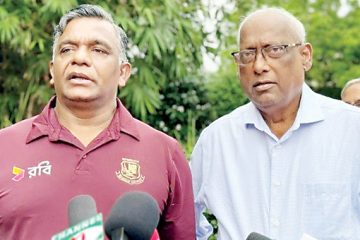Nafis Almas Siam
After retiring from Twenty20 Internationals, when people will look back on Mushfiqur Rahim’s 16-year career in this format, they will remember him more for the runs he could not score rather than for the runs he scored.
Mushfiq ended his T20I career with the Asia Cup match against Sri Lanka, with 102 matches and 15,00 runs in his bag.
But if one looks at his career that started in 2006 against Zimbabwe in Khulna, one might wonder how he managed to continue for this long.
Among all the batsmen who featured in more than 100 T20I matches, the 35-year-old wicketkeeper-batsman holds the lowest batting average, as well as the lowest strike rate.
He also stands at the very bottom in these aspects when it comes to the list of 46 batsmen that scored 1500-plus runs.
His average in T20Is is only 19.48, while his career strike rate is 115, which is unacceptable for a batsman batting at number four or five throughout his career.
If Mushfiq’s runs, average, and strike rate aren’t taken into account, and if we look into how many memorable innings he played to take Bangladesh to the winning shore, he is lagging behind in this aspect too.
Instead, we will find way more matches where he failed to play a decent innings to take the team to a winning position.
He sunk matches during the most intense and important moments, when the team was desperately depending on his bat for some good and quick runs.
No cricket fan of this country will ever forget the 2016 T20 World Cup defeat against India at Bangalore, where Bangladesh only needed two runs from three balls, and Mushfiq was at the wicket.
Instead of finishing off the match steadily, he went for a glory shot and deprived the team of the glory of defeating the home team in front of thousands of home crowds.
Mushfiq has featured in the team since Bangladesh played its first ever T20I and took part in all the T20I tournaments, and he has been a flop in those tournaments.
In the Asia Cups and the T20 World Cups, he has averaged 7.45 and 17.47, respectively. Despite playing 35 innings in these two competitions, he only managed to accumulate one half-century only.
The fact that Bangladesh haven’t been able to manage a win in the main rounds of T20 World Cups since the 2007-win against West Indies, Mushfiq and his lack of decent innings have to be held accountable for that.
However, Mushfiq had his good moments, too. Moments that helped the team win big. The finest year for him in T20Is was 2018.
He played several outstanding innings that year. In fact, he scored 397 runs that year with a strike rate of 132.33 and an average of 30.53 that year.
He played really well in the entire Nidahas Trophy, as his outstanding performance led Bangladesh to its highest successful run-chase, as he scored an unbeaten 72 off 35 balls to help Bangladesh pass the 214-run total set by Sri Lanka.
His bat also helped Bangladesh defeat India in a historic victory, as he played an unbeaten knock of 60 runs off 43 balls to see through the seven-wicket win in Delhi in 2019.
But it’s hard to praise him for a few standout games here and there. When most fans will look back at Mushfiq’s T20I career, they will remember him more for the matches he could not win for Bangladesh instead of the ones he could.




















